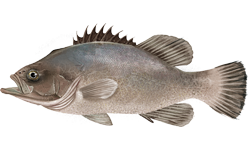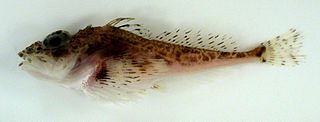
The Cyclopteridae are a family of marine fishes, commonly known as lumpsuckers or lumpfish, in the order Scorpaeniformes. They are found in the cold waters of the Arctic, North Atlantic, and North Pacific oceans. The greatest number of species are found in the North Pacific. The family name Cyclopteridae derives from the Greek words κύκλος (kyklos), meaning "circle", and πτέρυξ (pteryx), meaning "wing" or "fin", in reference to the circle-shaped pectoral fins of most of the fish in this family.

The wreckfish are a family, Polyprionidae in the suborder Percoidei of the order Perciformes.

The scaled sculpins, Icelus, are a genus of marine ray-finned fishes belonging to the family Cottidae, the typical sculpins. Most of the fishes in this genus are found in the northern Pacific Ocean but they also occur in the North Atlantic Ocean.

Cyclopterus is a genus of marine ray-finned fish belonging to the family Cyclopteridae, the lumpsuckers or lumpfish. Its only species is Cyclopterus lumpus, the lumpsucker or lumpfish. It is found in the North Atlantic and adjacent parts of the Arctic Ocean, ranging as far south as Chesapeake Bay on the North American coast and Spain on the European coast. The species has been reported twice in the Mediterranean Sea, off Croatia in 2004 and Cyprus in 2017.
The giant clingfish is a clingfish of the family Gobiesocidae, the only species in the genus Haplocylix. It is found all down the east coast of New Zealand around the low water mark amongst seaweed, on rocky coastlines. Its length is up to 15 centimetres (5.9 in). This species was originally described as Cyclopterus littoreus in 1801 by Johann Reinhold Forster, John C. Briggs subsequently placed it in the monotypic genus Haplocylix. Its closest relative appears to be the Caribbean deepwater clingfish Gymnoscyphus ascitus.

Myoxocephalus is a genus of marine ray-finned fishes belonging to the family Cottidae, the typical sculpins. They are found in the norther Pacific, Arctic and Atlantic Oceans, with a few species in lakes.

Chelidonichthys, the smallscaled gurnards, is a genus of marine ray-finned fishes belonging to the family Triglidae, the gurnards and sea robins. These gurnards are found in the Eastern Atlantic, Indian and Western Pacific Oceans.

Liparis liparis, the common seasnail, striped seasnail or seasnail, is a small species of marine ray-finned fish belonging to the family Liparidae, the snailfishes, in the order Scorpaeniformes, the scorpionfishes and flatheads. It is found in the northeastern Atlantic Ocean where it lives on the seabed.

Artediellus is a genus of marine ray-finned fishes belonging to the family Cottidae, the typical sculpins. Most of the fishes in this genus are found in the northern Pacific Ocean but they also occur in the Arctic and North Atlantic Oceans.

Hemilepidotus, the Irish lords, is a genus of ray-finned fishes belonging to the family Agonidae, the poachers and sea ravens. These fishes are found in northern Pacific, northern Atlantic and the Arctic Oceans.

The smooth lumpfish is a species of marine ray-finned fish belonging to the family Cyclopteridae, the lumpfishes and lumpsuckers. This species is found in the northern Pacific Ocean. It is the only species in the monospecific genus Aptocyclus.
Cyclopteropsis is a genus of marine ray-finned fishes belonging to the family Cyclopteridae, the lumpfishes or lumpsuckers. These small lumpfishes are found in the North Pacific and Arctic Oceans.

Eumicrotremus is a genus of lumpfishes native to the northern oceans. The name for this genus comes from the Greek roots eu meaning "good", mikros meaning "small" or "little", and trema meaning "hole".

Cottunculus is a genus of marine ray-finned fish belonging to the family Psychrolutidae. These fishes are found in the Atlantic, Pacific and Arctic oceans.

Myoxocephalus scorpioides, the Arctic sculpin or northern sculpin, is a species of marine ray-finned fish belonging to the family Cottidae, the typical sculpins. This fish is found in the Arctic Ocean.
Eumicrotremus schmidti is a species of lumpfish native to the Northwest Pacific. It is a demersal fish known only from the northern Sea of Okhotsk, where it is found at a depth range of 20 to 143 m. Specimens of E. schmidti were once attributed to the related species E. andriashevi, which does not inhabit the Sea of Okhotsk. This species was first formally described in 1955 by the Soviet ichthyologists Georgii Ustinovich Lindberg and Marina Iosifovna Legeza with its type locality given as Penzhinskaya Bay in the Sea of Okhotsk in Russia. The identity of the person honoured in the specific name was not given by Lindberg and Legeza but it is likely to be Petr Yulievich Schmidt, a Russian ichthyologist.
Eumicrotremus tokranovi is a species of lumpfish native to the Northwest Pacific, and one of two species some authorities place in the genus Microancathus. It is known from the Kuril Islands. It is distinguished from the closely related E. fedorovi by a taller body and flatter and less developed bone plaques. FishBase does not recognize the genus Microancathus,. This species was described by the Russian ichthyologist Olga Stepanovna Voskoboinikova in 2015 in the proposed new genus, Microancathus and the reclassification of M. fedorovi in that genus. Catalog of Fishes does not recognize the new genus and classifies this species in Eumicrotremus. The specific name honors the ichthyologist Alexei Mikhailovich Tokranovof the Kamchatka Branch of the Pacific Institute of Geography and the Far East Branch of the Russian Academy of Sciences.

Stichaeus is a genus of marine ray-finned fishes belonging to the family Stichaeidae, the pricklebacks or shannies. These fishes are mainly found in the North Pacific Ocean with one species in the Arctic and western North Atlantic Oceans.

The Arctic shanny is a species of marine ray-finned fish belonging to the family Stichaeidae, the pricklebacks and shannies. This species occurs in the North Pacific, Arctic and western North Atlantic Oceans.
Eumicrotremus fedorovi is a species of marine ray-finned fish belonging to the family Cyclopteridae, the lumpfishes or lumpsuckers. This species is found in the northwestern Pacific Ocean around the Kuril Islands. It is a demersal fish that occurs at a depth range of 115 to 370 m. This species was first formally described in 1991 by Sergey Anatolyevich Mandritsa with its type locality given as the Rikord Strait. The specific name honours the Russian zoologist Vladimir Vladimirovich Fedorov who studied the holotype and suggested that it represented a new species.

















